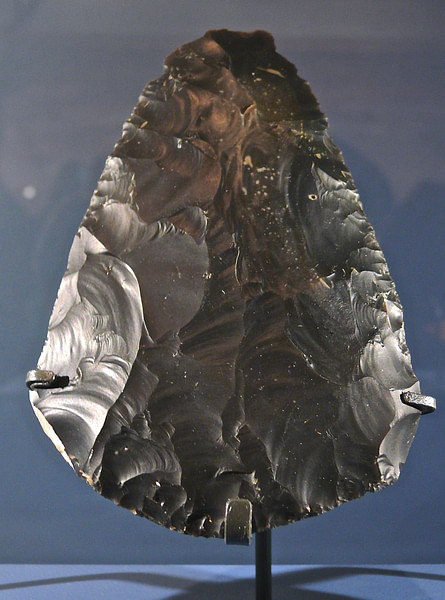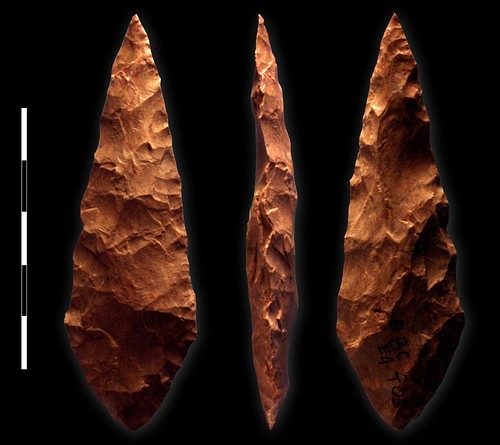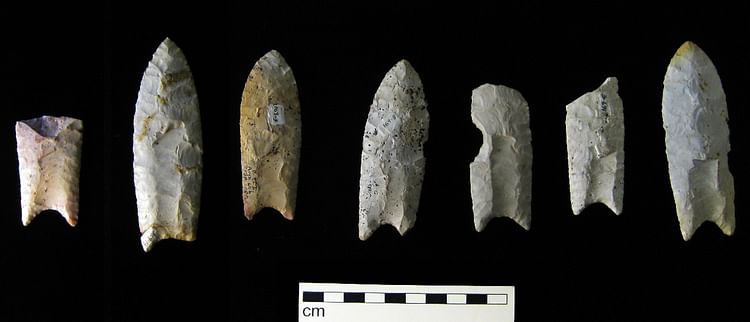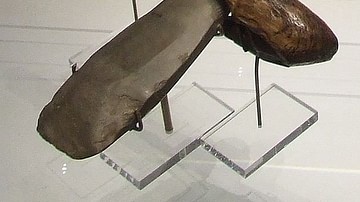
The Palaeolithic ('Old Stone Age') makes up the earliest chunk of the Stone Age – the large swathe of time during which hominins used stone to make tools – and ranges from the first known tool use roughly 2,6 million years ago to the end of the last Ice Age c. 12,000 years ago, with part of its stone tool culture continuing up until c. 10,000 years ago in some areas. As such, it corresponds neatly with the timeframe of the geological epoch the Pleistocene, which saw waves of glacials and interglacials sweep across the planet. The term's connotations extend beyond the characteristics of its stone industries, however, as the Palaeolithic is also more generally associated with the cultures and lifestyles of the hunter-gatherers who produced the tools in question.
It is succeeded by the Mesolithic ('Middle Stone Age'), in which people adapted to the changing environment after the end of the most recent Ice Age, and the Neolithic ('New Stone Age') which saw the spread of agriculture and ended with the coming of shiny bronze tools. As a measure against current-day self-importance, it might be interesting to mention that the Stone Age as a whole makes up around 99% of humanity's technological calling card - so stone tools were very much in vogue for a long time indeed.
Subdivisions
With the Palaeolithic spanning such an almost incomprehensibly huge timeframe, thankfully our organisationally oriented modern human minds have come up with some subdivisions. Looking at the different 'stages' and characteristics we think we can see in stone tool cultures across the world during this period – and, crucially, not at absolute chronological boundaries - has produced the following highly unoriginal labels:
- Lower- or Early Palaeolithic - From the earliest known tool use around 2,6 million years ago, with simple cores, flaked pieces, and later large bifaces, up to roughly 250,000 years ago;
- Middle Palaeolithic - From c. 250,000 years ago, with a new focus on retouched flakes and prepared cores, which continued to be popular in certain areas until as late as c. 30,000 years ago (when other areas had already made the switch to what we see as Upper Palaeolithic tools);
- Upper- or Late Palaeolithic - Beginning to pop up around 50,000/40,000 years ago, this industry saw a huge proliferation with regard to both tool shapes and source materials (now also a lot of bone, antler, and ivory), which in some areas was carried on beyond the end of the last ice age all the way up to c. 10,000 years ago.
Of course, humans would not be humans if they did not also distinguish some more specific tool industries within these categories, too. As such, the Lower Palaeolithic, for example, houses the Oldowan and Acheulean industries; the Middle Palaeolithic basically cries out 'Mousterian'; and the Upper Palaeolithic has too many to name but includes among others the Châtelperronian, Aurignacian, Gravettian, Solutrean, and Magdalenian in Europe and the Clovis and Folsom cultures in the Americas. It should be noted that of course, these are artificially constructed boxes, which not only oversimplify things but might also not do justice to the grey areas and transitional stages. Developments can moreover vary greatly between different places.
Lower- or Early Palaeolithic
So far traced back to around a staggering 2,6 million years ago in Africa is when some early humans first began making simple stone tools. The first identified industry is the Oldowan industry, named after Olduvai Gorge in Tanzania, in which hunter-gatherers used simple stone cores as choppers and hammerstones, for example for butchering animals and crushing their bones to get at the nutritious marrow, or pounding up plants and seeds. The Oldowan was mostly found within Africa (in spots that correspond with, for example, present-day Tanzania, Kenya, Ethiopia, and South Africa) but was later on found in the Near East and eastern Asia, too, most likely by courtesy of the long legs of adventurous Homo erectus. It overlaps a bit with the Acheulean industry which popped up a bit later, around 1,7 million years ago, and has no proper endpoint; rather, it seems to have gradually petered out in various areas and given way to the Acheulean. To sustain our box-thinking, though, archaeologists tend to set the general conclusion of the Oldowan around one million years ago.
The Acheulean, characterised by large bifaces that were turned into all kinds of scary things such as hand axes, picks, and cleavers, first developed in Africa and then spread through Eurasia. It accompanied the migrations of such humans as Homo erectus and Homo heidelbergensis across Europe and Asia and enabled them to process their kills and side-dishes much more effectively. These humans also gradually figured out how to harness fire properly and by at least 400,000 years ago habitual fire use becomes visible in the archaeological record, allowing cooking to help kick off all sorts of bodily developments (bigger brains!).
Middle Palaeolithic
The Middle Palaeolithic (c. 250,000- c. 30,000 years ago) of Europe, the Near East, and North Africa is identified when the previously hugely popular bifaces give up their spot in the limelight for retouched flakes that are struck from carefully prepared cores (known as the Levallois technique) to create tools such as side scrapers, points, and backed knives. Clearly, tools became useful in more and more different ways as time progressed, and helped humans around this time conquer ever more challenging environments throughout almost the entire Old World.

Middle Palaeolithic sites moreover show the presence of local traditions and variation. Human groups still mostly used natural shelters such as caves and rock shelters, but these now slowly began to have separate areas designated for specific activities, and fire and hearths become much more common. Associated humans are most prominently the Neanderthals (Mousterian industry) but also early Homo sapiens.
Africa around this time was home to the Middle Stone Age technology (or MSA, not to be confused with the Mesolithic, and not synonymous with the Middle Palaeolithic), which also used prepared core techniques to produce a range of flake-based tools but more unusually also already showed signs of hafting (attaching points and flakes to handles, like with a spear), use of bone tools, and use of pigment and shells hinting at symbolic thought. A prime example is Blombos Cave in South Africa.
Upper- or Late Palaeolithic
The Upper- or Late Palaeolithic industry (c. 50,000/40,000- c. 10,000 years ago) represented an explosion in tool diversity. Stone gave up its status as prime source material to stuff such as bone, antler, and ivory, which were shaped into intricate needles, points and burins (engravers/chisels with sharp, chiseled points or edges) – although blade tools made of stone were still created, too. Sewing was now definitely within the realm of possibility, and spear throwers, harpoons, and bows and arrows indicated a serious change to their makers' way of life, allowing for much more varied hunting behaviour. Ever stronger regional material cultures became visible, so that a lot of areas have their own label referring to the specific ins and outs of their toolmaking.
The Upper Palaeolithic generally goes hand-in-hand with Homo sapiens, but some Neanderthals appear to have (either directly or indirectly) come into contact with their culture and borrowed some aspects, too (and vice versa, by the way), and the Upper Palaeolithic Châtelperronian industry, distinguished by curved backed blades, was also likely produced by Neanderthals. Culturally, anatomically modern humans created bucket loads of art and figurative objects, as symbolic expression becomes unequivocally visible within the framework of this industry, while Neanderthals also show decorative skills and some burials are known for them.
By the time the glaciers of the last ice age began to recede and the Holocene epoch began around 12,000 years ago, humans had conquered not only the Old World but had made it all the way into the southern tip of Australia and the Americas. This warmer period, sandwiched between the temperamental climatic conditions accompanying the Palaeolithic cultures and the advent of agriculture that marks the start of the Neolithic, saw the Upper Palaeolithic industry give way to the Mesolithic. As humans sought to adapt to the post-glacial climate and changing flora and fauna, different tools (such as forest-clearing axes) were needed and microliths (small flint blades generally only 5 mm long and 4 mm thick) became the archetypal tool forms. Luckily, throughout the Palaeolithic, various human species had run the race of developing their technology fast enough to keep up with the challenges nature threw at them, priming them for these new challenges to come.












